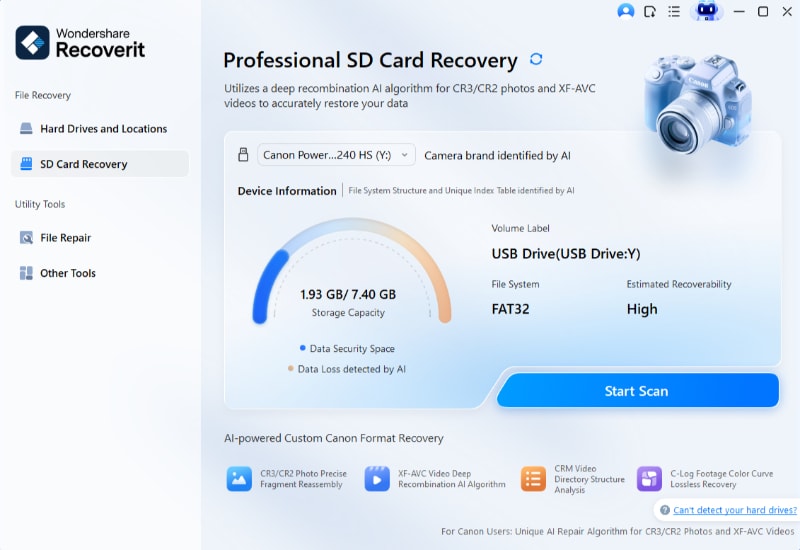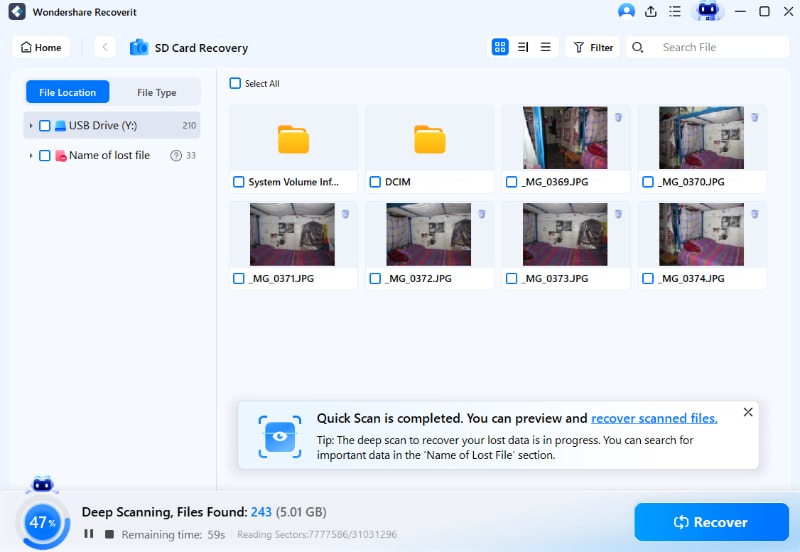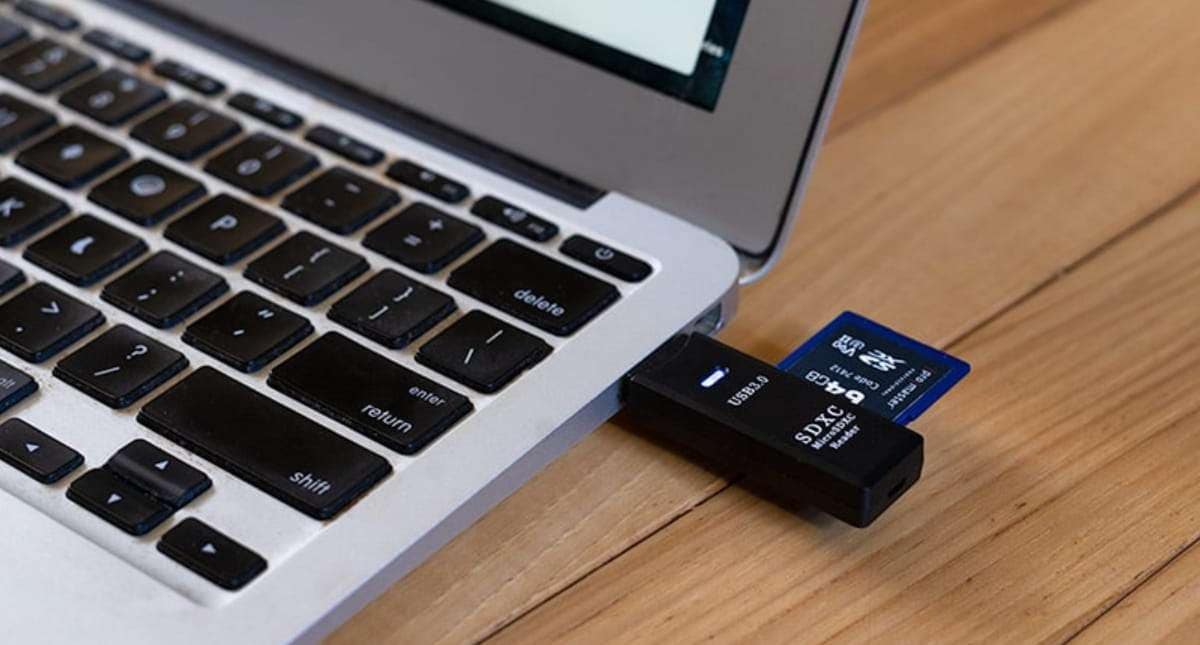What is an SD Card and What Format for Your Devices
What is an SD card? Secure Digital cards, more popularly known as SD cards are the most popular portable storage media widely used on mobile devices such as mobile phones, digital cameras, voice recorders, and much more.
They were first launched back in the late 1990s and are now available in many capacity types, speed classes, and bus interfaces. New SD card standards are also announced often.
Part 1. How SD Cards Work
To answer the "what is an SD card" question, you need to understand how SD cards work. Below is a detailed explanation.
Types of SD Cards (Form Factor and Capacity)
In 1999, the first SD card, which we now refer to as the standard size, came to the market. Mini SD cards soon followed in 2003, and in 2005 even smaller micro SD cards became commonplace.
Mini SD cards are no longer as common. Most contemporary devices use either a standard or a micro SD card. The mini SD card no longer has support on new SD card specifications.
There are four types of SD cards:
- SD: The first is known as SD and supports cards up to 2 Gb.
- SDHC: The second is the SDHC or Secure Digital High Capacity. It supports cards over 2Gb gigabytes and goes up to 32 Gb.
- SDXC: The third is the SDXC or Secure Digital Extended Capacity Card supporting sizes of over 32 Gb and going up to 2Tb.
- SDUC: In mid-2018 the SD Card Association came up with a fourth capacity type known as SDUC or Secure Digital Ultra Capacity. This supports cards over 2Tb up to 128Tb. This has the potential to offer massive storage capacity on a medium the size of a fingernail.

Speed and UHC Speed Class
Common SD card labeling shows up to three different speed classes. All three indicate the minimum sequential write speed.
The original SD card speed classes were 2, 4, 6, and 10. This number appears inside the letter C. This shows that the storage has a minimum write speed of 2, 4, 6, or 10 megabytes a second (MB/s) respectively.

UHS or Ultra High-speed class was the next development. This shows that a card can sustain a sequential write speed of either 10 or 30 MB/s. The number 1 or 3 are placed inside the letter U.
SD card labeling now includes a video speed class with the figure 6, 10, 30, 60, or 90 appearing after the letter V. The video speed class indicates a minimum sustained write speed of 6, 10, 30, 60, or 90 MB/s.
Of note is that manufacturers often use labeling showing a speed attained in testing. For example, below are two cards with labeled speeds of 95 and 170 MB/s. However, both cards are only classified as U3 and V30 meaning a write speed of 30 MB/s.

The truth is usually found on the box or product documentation that comes with cards. Most times, the claimed speed is a potential maximum speed.

You may also have noticed some box labels have a multiplication rate printed on them. Such multiplication rates are not sanctioned by the SD Card Association specifications but are frequently quoted by manufacturers. What they show is how the potential speed of a card compares to a CD ROM drive, which transfers data at roughly 0.15 MB/s. Thus, a card showing 633X may work 633 times faster than a CD ROM drive.

Finally, the labeling on some cards comes with a fourth class referred to as an application performance class. This is Class one, written as A1, or class two, which is written as A2. The minimum sustained write speed is 10 MB/s, similar to a Class 10, U1, or V 10 card. But A1 and A2 cards have certification for a minimum number of input-output (IOPS) operations per second.

BUS Interfaces
Today, SD cards and devices come with various bus interface standards. In computing, a bus is a system that interfaces peripheral devices with the processor.
This affects the data transfer speed. It is a hardware specification that's different from the SD cards. There are currently 4 standards as follows:
- High Speed
- UHS-I
- UHS-II
- UHS-III
They offer potential maximum data transfer speeds of 25, 104, 312, and 624 MB/s. Ordinarily, all you see shown on a card is a single Roman numeral with the labeling on most modern SD cards being I or II to show they have either a UHS-I or UHS-II Bus interface. UHS stands for Ultra High speed, but this differs greatly from the UHS speed class.

High speed or UHS-I bus interface SD cards transfer data over a single connecting pins. But, to attain higher data transfer speeds, UHS-II and UHS-III cards need another row of connectors. It is therefore relatively easy to tell between a slower or faster card by looking at the connecting pins.

The Security of SD Cards
Why the word "Secure" in Secure Digital? The reason for this is that they come with copyright protection technology using a feature known as Content Protection for Recordable Media (CPRM). This was developed by a company known as 4C Entity, LCC. This organization handles copyright protection licensing for Toshiba and Panasonic, both co-founders of the SD Association, and Intel and IBM.
CPRM made it possible for commercial content distributors to put content on SD cards and prevent illegal copying. However, it doesn't apply automatically. To protect data using CPRM, the device you are using to save data must create a Media Identifier and Media Key Block (MKB) in a protected section. Data stored in this section can't be accessed using the storage media's system, only a CPRM-enabled device can do so by decrypting the data.
The other security feature is a physical switch on 32 x 24-millimeter SD cards. When you slide it into a lock position, the storage becomes read-only. This protects it from accidental deletion or data overwriting. To write data to it, slide the switch into an unlock position.
Challenges in Using SD Hardware
While these devices are small, durable, and usable on many devices, they do come with a few challenges.
To begin with, there are flash memory limitations that technology is yet to surmount. According to Toshiba, the memory has a maximum write/erase cycle of 10,000 times. After this, the hardware is no longer functional.
There is also physical handling. Despite the vast memory sizes, they now come with, they are tiny gadgets that can easily be lost or damaged. They are also easy to steal and conceal.
Also, the specifications printed on the card and boxes are highly technical. Most laypeople do not know how to select the right SD card for their devices and uses.
Part 2. Best SD Card File Format
Now that we have learned what is an SD card, the next thing most people want to know is to format them and the correct file format to use. These are tough questions for most people.
There are three main file systems:
FAT32
FAT is an abbreviation for the File Allocation Table. FAT was originally developed in 1977 and later by Microsoft. It has gone through three important modifications FAT12, FAT16, and FAT32.
FAT32 is the default file system for removable storage such as SD cards, USB flash drives, and flash memory cards. It is supported by most portable devices such as mobile phones, go pro cameras, digital cameras, PDAs, media players, and video game consoles.
Despite being the default file system for removable storage, FAT32 has its limitations. The greatest limitation is the maximum file size and partition size, with capping at 4GB and 2TB, respectively. This makes it impractical for users who work with large files. For example, professionals in the media and film industry would often have video files larger than 4Gb. FAT32 is also impractical for uses such as surveillance. Footage from security cameras is often massive.
exFAT
exFAT is an abbreviation for Extended File System and solves the limitations of the FAT32 while retaining the wide compatibility feature. It was launched in 2006. The SD Association adopted exFAT as the default file system on SDXC storage media with capacities of over 32Gb. The file size limit is 16 exbibytes (about 10^19 bytes), making it practically limitless. It also performs faster as opposed to FAT32.
NTFS
NTFS is an abbreviation for NT File System and is a proprietary file format owned by Microsoft. Like exFAT, it also has a theoretical maximum file size of 16 exbibytes and is much faster than FAT32.
The main disadvantage of NTFS is its incompatibility with mobile devices. For example, unrooted Android devices can't work with NTFS, and neither do digital cameras and other smart devices. NTFS works well with devices running Windows and on the Xbox gaming console.
Different Ways to Format an SD card
There are many ways to format an SD card depending on the intended use and the type of device. But, why would you want to format an SD card in the first place? There are several reasons:
- The SD card is corrupt and inaccessible. This may be evident through error messages on the device.
- The storage has become unallocated. Unallocated space means the storage is not ready for use. This can sometimes happen when an ongoing process is abruptly interrupted or the device is not ejected correctly.
- You want to use the SD card on a different device or for a new purpose. For example, you anticipate needing to store files larger than 4Gb in which case to must reformat it from FAT32 to exFAT.
The first thing you must do before you format is to create a backup. This is because formatting wipes the storage of all contents. You can back up to a cloud service such as Google Drive on Android.
You can also connect the storage to a computer and copy all the contents to a location on the hard disk.
After backing up, use any of the following methods to format the SD Card.
Method 1. Format SD card on the Mobile Device
Most mobile devices such as smartphones, cameras, and video game consoles have a formatting feature located in the system settings menu. You just need to locate it and press/tap format. For example, on an Android phone, follow these steps:
- Go to Settings.
- Then, Storage.
- Tap the SD Card then tap Format SD card.

When you use this method, the device automatically chooses the File System based on the default settings.
Further Reading:
Method 2. Format SD card on Windows PC
The next method involves using a PC. The advantage of this method is that you choose the file system. Follow these steps:
- Connect the SD Card to the computer and ensure it has been detected.
- Go to This PC, right-click on your storage, and click Format.

- Choose the preferred file system from the drop-down menu.
- Enter a name in the Volume Label field and check the Quick Format
- Press Start.

After a few minutes, the format is complete. Still cannot format the SD card on Windows? Here are 5 Solutions to Fix Windows Was Unable to Complete the Format SD Card
Method 3. Format SD card on Mac
If you are a Mac user, here is a complete guide on formatting an SD card on Mac. Take a look!
Part 3. SD Card Data Recovery
Any discussion on formatting SD cards would be incomplete without delving into data recovery. This is because many people forget to back up their storage devices and format. They later realize they have lost all their data.
If you have been an unfortunate victim of such an eventuality, calm down. You can get your files back.
Even though formatting erases files on a disk, the reality is that data storage is a complex matter. While the files may not show up when you insert the storage in a phone, camera, or computer, the files are retrievable using advanced data recovery software.
Wondershare Recoverit Data Recovery is one such tool and has come to the rescue of many people who would be very sad were it not for this nifty tool. Recoverit scans the sectors in storage media for data fragments, reassembles them into the original files, and then lets you save them in a different location.
The tool is compatible with Windows and Mac. It can recover files in any format and can even repair video files. Download the tool, install it, and launch it using the shortcut icon on your desktop. You can also launch it from the Windows search box by typing "Wondershare Recoverit" and clicking the app.
To recover your files, connect your SD card to the computer and follow the steps below:
Step 1. Locate Your SD Card
Check the SD Card section to locate your storage device. Click the Scan button to start scanning the drive.

Step 2. Scan Your SD Card
The tool scans your storage media. Here you can see the progress and pause it at any time.

Step 3. Recover Your Files
Choose the files you want to keep, click Recover, and then save them in a different location on the computer.

Part 4. More Tips about Memory Card
To get the most out of your SD card, we suggest you follow the following tips.
Use and compatibility
SD cards are pretty much universally compatible. You can stick any SD card into any camera, and it will probably work just fine. More expensive is not better. If you don't shoot action sports, wildlife, or 4K video, then an affordable regular one with a speed class rating of C4 is good for most regular phone and camera users. But, if you are into activities where speed and capacity are important, then you must invest in something with a little more punch in terms of speed class, application class, and bus interface speed.
Physical Care
Handle SD storage media with care. Even though they are sturdy by design, they are still susceptible to water and dust. When not in use, store them in a dry dust-free place. Also, follow the recommended ejection protocols when removing them from devices. Also, avoid abruptly interrupting running processes.
Format Them Regularly
Formatting helps ward off potential problems. It is a good idea to format when you move from one device to another. Backup before you format, but if you forget to do so, you can always turn to Wondershare Recoverit Data Recover Software to get your files back.
Conclusion
We hope we have answered that burning question, "what is an SD card". With the rapid development of SD technology, it is safe to assume that they will be around for many years to come. The future looks bright because of the wide adoption of SD standards.
Memory Card FAQs
How should I format my SD card?
You can format using a mobile device such as a smartphone or camera. Alternatively, you can use a PC by going to File Explorer, right-clicking the storage, and selecting Format.
What is the best SD card for GoPro and Switch?
GoPro cameras need high-performance storage devices with a Video Speed class rating to achieve the best results. It is best to check the manufacturer's specifications for details on the best memory card for your specific device. As for the Nintendo switch, it requires high-performance memory cards. We recommend a minimum bus interface rating of UHS-I.
What are the types of memory cards available?
There are four basic types, SD, SDHC, SDXC, and SDUC.
Can I use the same card on other devices?
Yes, but with some caveats. It depends on whether the file systems used by the devices are the same. Also, some older devices may not have support for newer SDXC and SDUC.
How safe is the data stored on memory cards?
Memory cards are less fragile and less prone to physical damage than DVDs and hard drives. However, they are also small, which means they get lost easily.
How do I transfer data from my memory card to my PC?
Connect it to your PC using an adapter. Use File Explorer to navigate to the storage. Select all the files and folders, copy and then paste them in a different location on your PC.
SD Card Troubleshooting
- Recover Data from SD Card
- Card Repair Solutions

















 ChatGPT
ChatGPT
 Perplexity
Perplexity
 Google AI Mode
Google AI Mode
 Grok
Grok
























Eleanor Reed
staff Editor